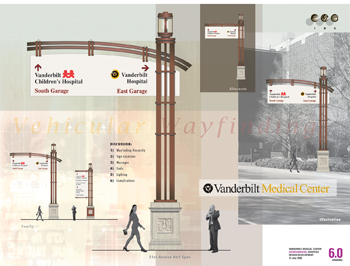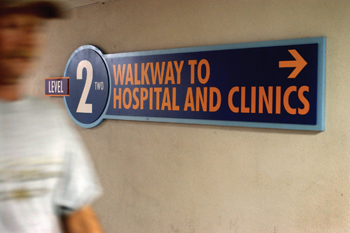
The first objective of the new signage system is to guide visitors to the correct building.
New signage system to help patients, visitors find their way

VUMC’s new ‘way-finding’ system is a comprehensive, integrated system of signs, design elements and visual clues to help patients and visitors make their way around the Medical Center’s growing campus.
photo by Dana Johnson
Vanderbilt University Medical Center will soon begin installation of a comprehensive “way-finding” system to help patients and visitors navigate a complex and rapidly growing campus.
“Our first goal is to help people enter campus at the right place, get them into the right garage and guide them to the right building,” said Ann McGauran, architect with Medical Center Space and Facilities. “We want to lead them to a point where they can find a person to ask for help or directions if they need it.”
Way-finding is much more than putting up new and more signs; it's an integrated system of signs, building design elements, visual clues and information systems to guide an individual to his or her desired destination.
The approach is evident in the Monroe Carell Jr. Children's Hospital at Vanderbilt and was incorporated in the design of the new Medical Center East South Tower. Some elements are also already in place through temporary signs in and around the South Garage, but installation of the comprehensive exterior plan will begin in December, starting with the streets, garages and building exteriors.
Rollout of the interior components is expected to begin next spring. Interior way-finding will also be incorporated as areas of the hospital and clinic are renovated and upgraded.
At a cost of more than $5 million, it is a massive undertaking.
“To put it in perspective, the total cost is greater than the construction of the Dayani Center,” McGauran said. “It included more than 5,000 signs in the new Medical Center East South Tower alone. The exterior phase includes more than 200 signs. Faculty and staff may have been hearing that this plan was under development for a while and may have been wondering what was taking so long.
“One of our challenges has been to make sure the funds were available to roll the plan out in big chunks because so much of the elements work together and build on each other.”
The plan was developed by a working committee that in addition to McGauran included Charlotte Chaney, assistant hospital director; Racy Peters, director of common systems for Vanderbilt Medical Group; Ken Browning, director of Plant Operations; Joel Lee, associate vice chancellor for Communications; and Fred DeWeese, vice president for Facilities Planning and Design.
It was designed from the visitor's perspective, to anticipate when and where visitors will ask “Where do I go? Where do I find…?” and to answer those questions in a format and in a location that would make sense to someone coming to our campus for the first time.
Details as simple as on which side of the street a sign is located and what specific names are used to identify buildings are important.
For instance, use of building-name abbreviations like MCN, MCE and MCS will be eliminated because, while that shorthand makes sense to faculty and staff, it does not to visitors. Directional signs in the garages and on the streets will use main building names and not individual clinics and centers because the goal is to get visitors to the right building first and to the right clinic or department from there.
Key features of the plan include:
• Construction of prominent “gateway sentry posts” at the main entrances to the campus.
• Clear directional signs designed specifically to guide drivers along with complementary pedestrian signs to guide patients and visitors once they leave their vehicle.
• Signs for pedestrians throughout the lengthy plaza from Children's Hospital to Medical Center North to frequently let visitors know what still lies ahead.
• Identification of garage entrances along with the primary buildings served by that garage and that entrance.
• Visible names of buildings along with numerical addresses to guide those who are seeking a specific street address but do not know the building name.
• Information pylons, floor directories, electronic information boards, kiosks and a more logical system of naming, numbering and labeling clinics, suites and rooms.
• Graphics and visual clues to augment signs, similar to the murals and graphics used to distinguish floors in Children's Hospital but with a more adult feel.
• A distinct graphic style — called “jewelry” — to provide appropriate donor recognition that does not potentially interfere with way-finding by confusing visitors. (To see an example, look at the way the Bill Wilkerson Center is identified on the exterior of Medical Center East-South Tower).
No amount of signage, however, will be successful alone. As the way-finding elements are put in place, it will be important for faculty and staff to use that nomenclature and those landmarks in their written and verbal directions for patients and visitors.
“Nothing will substitute for the human touch and providing caring assistance when asked,” McGauran said. “The way-finding features will be tools that we can use to better help our patients and visitors get around.”













